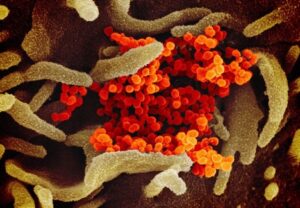Cover Image: A rural Metro ambulance in Memphis, Tennessee. Rural Metro is a fire protection and emergency medical service company originally founded due to lack of emergency response outside Phoenix, Arizona city limits. (Source: Wikimedia Commons, Thomas Machnitzki)

Over one sixth of the United States population lives in rural areas, but rural patients often have poorer health than urban patients. These disparities are attributed to less access to health care in general and to newer, digital forms of healthcare specifically (Douthit et al., 2015). These challenges unique to rural populations can greatly affect the quality of care provided.
One prominent difference between rural and urban areas is that of emergency response. For trauma patients, pre-hospital care – including on-site and ambulance care – greatly impacts patient recovery and chance of survival; the speed at which emergency responders arrive and the quality of the on-site care are therefore very important to patient outcomes (Alanazy et al., 2019). A meta-analysis of 31 papers comparing emergency medical services in rural and urban areas showed that time before reaching the hospital was much longer in rural areas compared to that in urban areas, with averages of 42 minutes and 24.8 minutes, respectively (Alanazy et al., 2019). Additionally, another meta-analysis of nine studies showed an average 8-minute increase in emergency response time – the time it takes for emergency responders to reach the scene – for rural patients as compared to urban patients, due to the larger distances emergency responders need to travel in rural areas. This disparity contributes to the higher general mortality rates seen in rural areas with a 1.78% rate in rural settings versus 0.90% in urban areas (Alanazy et al., 2019).
In four studies reporting on-scene time, transfer rates, and transport time, rural emergency medical services had longer on-scene times and transportation distances when compared to urban settings (Alanazy et al., 2019). Transport times in rural areas were also significantly higher by 5 to 9 minutes in comparison to urban areas; transport time to definitive care was also disproportionately high, with an average transport time of 11.6 hours in rural areas compared to 59 minutes in urban areas (Alanazy et al., 2019).
Because of these differences in emergency response, rural area trauma patients tended to have much lower survival rates than those in urban area with a ratio of 2.60 rural patient deaths to every 1 urban patient death. Urban patients had disproportionately higher chances of hospital admission, lower risk of mortality before arrival, and were more likely to survive after patient discharge. Moreover, rural patients had a higher chance of dying from cardiac arrest, strokes, and acute myocardial infarction than their urban counterparts (Alanazy et al., 2019).
Another major issue for rural healthcare moving forward is the technology gap in rural areas, in large part due to the often-poor internet connection. Telemedicine, an emerging method to provide virtual medical assistance over long distances, is deficient because of the lack of technology infrastructure; 14.5 million of the 19 million Americans (~3/4) without fixed broadband live in rural areas (Douthit et al., 2015). This lack of internet also impacts the ability of rural patients to look up health information online, which can help inform patients about their health. Sharing of medical records with different healthcare providers is impacted too (Cyr et al., 2019). Lack of medical technology that allows for this informational sharing can decrease quality of follow-up healthcare and worsen the overall patient outcome.
Despite these issues, however, the use of telemedicine still seems a promising avenue to overcome the physical barriers to healthcare in rural areas. Over these past several years, telemedicine has proven itself a very useful tool for patients to keep in contact with health providers long-distance. Although not quite a silver bullet to address the health inequities that exist between rural and urban areas, improvements to the rural technological infrastructure would increase patient access to medical information and medical consultation and improve the general health of rural America.
References
Alanazy, A. R., Wark, S., Fraser, J., & Nagle, A. (2019). Factors impacting patient outcomes associated with use of emergency medical services operating in urban versus rural Areas: A systematic review. International Journal of Environmental Research and Public Health, 16(10), 1728. doi:10.3390/ijerph16101728
Cyr, M. E., Etchin, A. G., Guthrie, B. J., & Benneyan, J. C. (2019). Access to SPECIALTY healthcare in urban versus rural US populations: A systematic literature review. BMC Health Services Research, 19(1). doi:10.1186/s12913-019-4815-5
Douthit, N., Kiv, S., Dwolatzky, T., & Biswas, S. (2015). Exposing some important barriers to health care access in the rural USA. Public Health, 129(6), 611-620. doi:10.1016/j.puhe.2015.04.001
Related Posts
Artificial Intelligence for Mental Health Services
Source: Pavel Danilyuk In recent years, due to the pandemic...
Read MoreThe “Old Friends” Hypothesis and the COVID-19 Pandemic
Authors: Sakeena Badrane1, Vivek Babu2, Sanah Handu1 1University of Pittsburgh,...
Read MoreAn International Team of Researchers Just Solved One of the Biggest Mysteries About the Human Heart
Figure 1: The heart is one of the most complex...
Read MoreThe COVID Brain
Cover Image: The Structure of the Coronavirus. (Source: Wikimedia Commons,...
Read MoreGenetic Cheating? Identifying CRISPR/Cas Gene Doping
Figure 1: Lance Armstrong, a well-known professional cyclist, has been...
Read MoreAre We Addicted to Social Media?
Cover Image: In the current age, social media has become...
Read MoreSonia Fung






